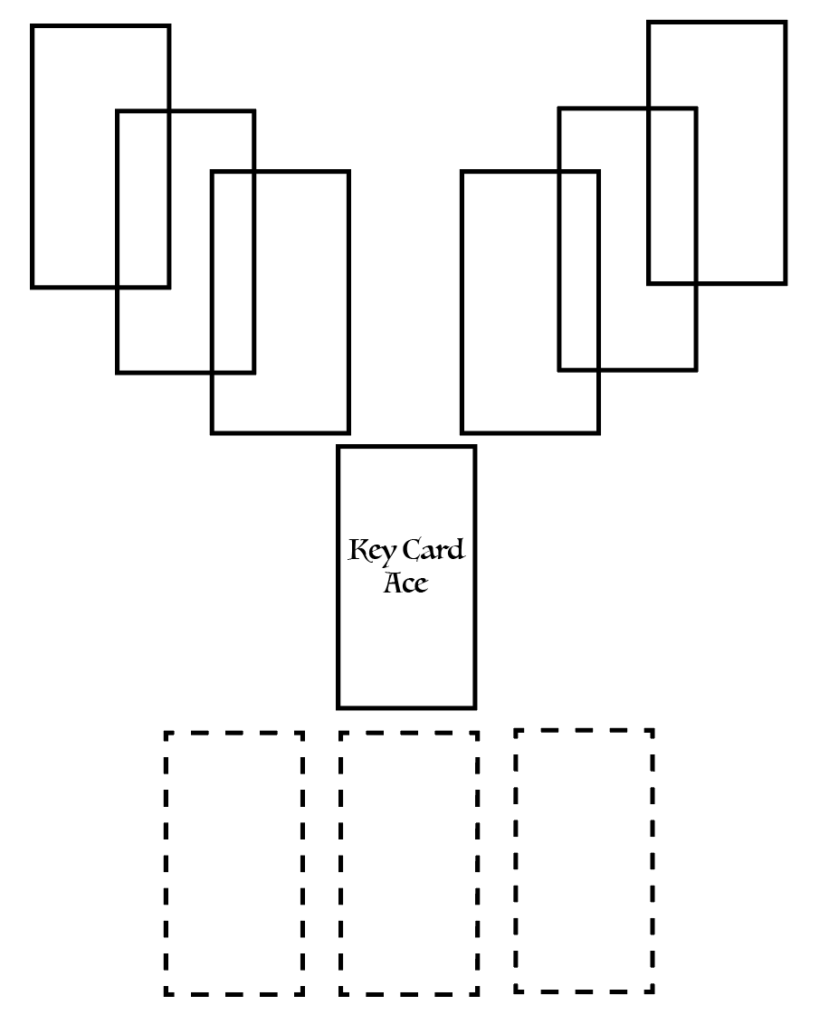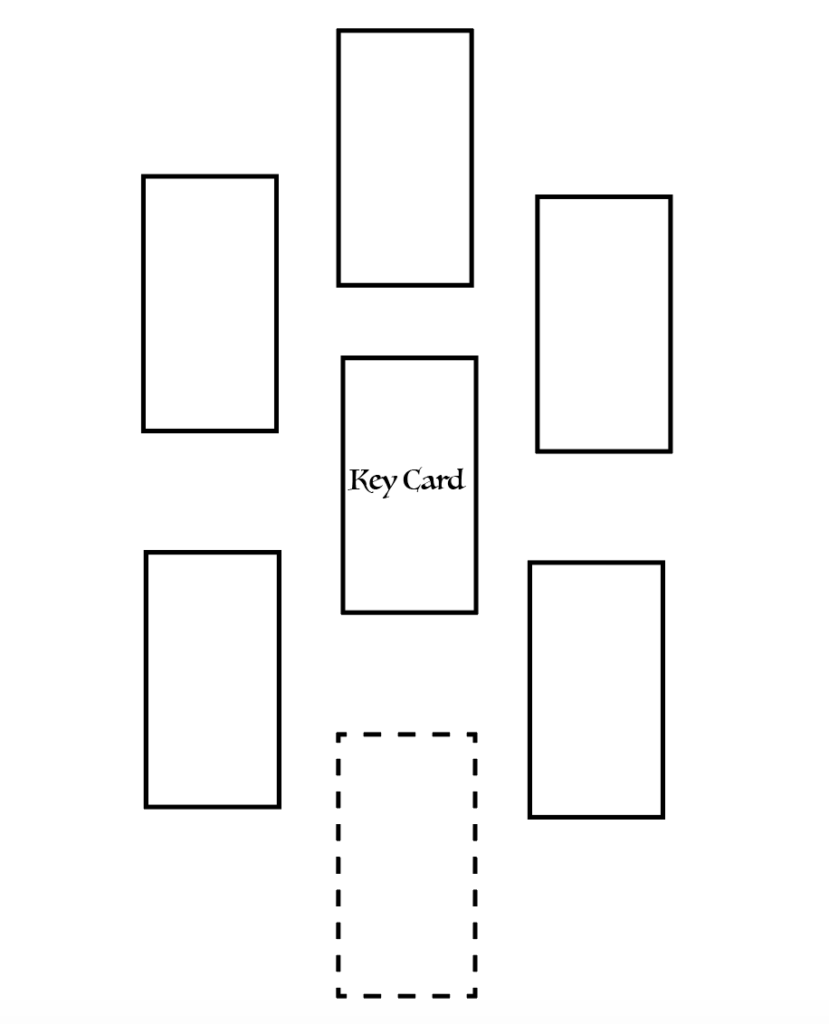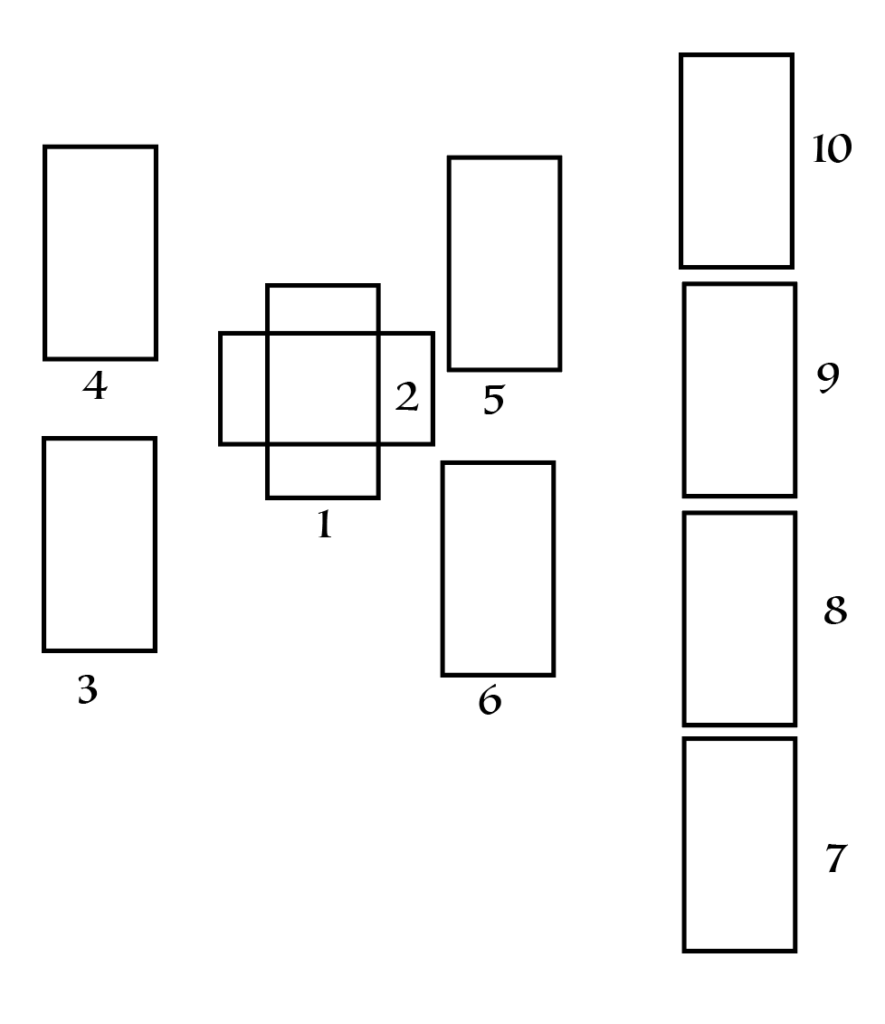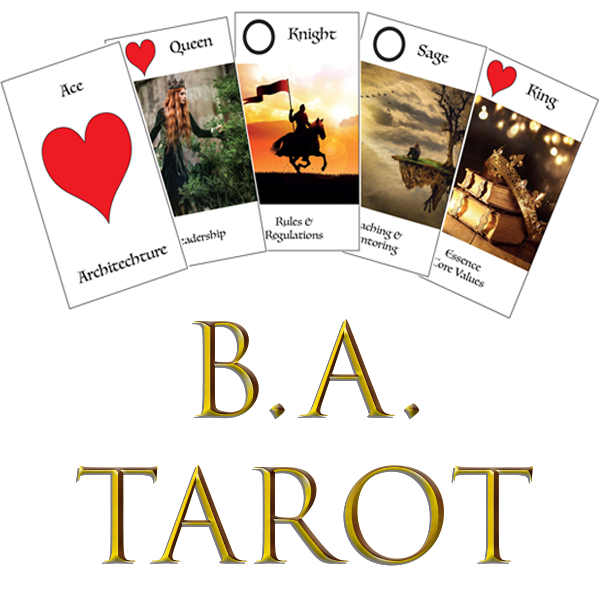
Techniques
This page describes some traditional tarot layouts and processes. The cards are not restricted to these layouts and techniques you can use whatever layout or technique you see fit.
I often simply lay out all the Aces and then just go through the cards one by one documenting comments and actions based on the subjects presented. I have used the cards within scenarios to question the subjects based on the scenario presented.
Feel free to play and try different things out – Please send me anything that you find useful and send me pictures of you using the cards.
7 card Horseshoe Reading
To consider a particular aspect:  This layout can be used to consider each suit in turn. The positioning keeps 6 aspects in view with the subject. Each card is positioned in a way that connects to different aspects of the problem or situation at hand. During the discussion key findings and cards that represent the highest priority can be moved to the left and the right of the Key Card for focus. If relevant the 3 holy trinity cards can be placed below. (see dotted line). Once each of the suits have been analysed the key cards can be put aside and analysed at a later date.
This layout can be used to consider each suit in turn. The positioning keeps 6 aspects in view with the subject. Each card is positioned in a way that connects to different aspects of the problem or situation at hand. During the discussion key findings and cards that represent the highest priority can be moved to the left and the right of the Key Card for focus. If relevant the 3 holy trinity cards can be placed below. (see dotted line). Once each of the suits have been analysed the key cards can be put aside and analysed at a later date.
For a higher level strategic analysis instead of each suit, each ace can be positioned in the V which gives an holistic view of the organisation.
The principal cards can then be placed below in the dotted area for discussion. Some times I reverse the V when sitting opposite the subject so that they can see the cards well.
The Pentagram Spread
To consider 5 (or 6) functional considerations:  The 4 Elements (represent Earth, Air, Fire and Water) are usually placed left and right – We don’t have elemental cards so choose 4 principal aspects of the subject. The central Key card represents the focus of the situation. The top and bottom cards are influences on the key card. As an alternative the left hand side can represent the”The Past” and the Right hand side ” The Future”.
The 4 Elements (represent Earth, Air, Fire and Water) are usually placed left and right – We don’t have elemental cards so choose 4 principal aspects of the subject. The central Key card represents the focus of the situation. The top and bottom cards are influences on the key card. As an alternative the left hand side can represent the”The Past” and the Right hand side ” The Future”.
The layout as a star the 5 pointed pentagram (or optional 6 points) can be used to reflect the key card with 5 or 6 influences upon that central subject.
I have also used this layout as an alternative method. Pile up each of the suits on each star point, starting with the ace and work through all the cards (Castle, King, Queen, Joker, Knight, Sage) to identify areas of strength/ weakness or to get an holistic view of the organisation.
The Celtic Cross
This layout and method is more complex and may or may not work for certain situations as it relies on the “chance” element of random card delivery from the pack. This results in random indications that may not be relevant-You may need to choose the cards you use in advance.
Shuffle the pack and give it to the subject to cut or shuffle and tell them to choose 10 cards from the deck. ( you can include the W’s and Trinity i fyou wish)
- Card 1: The Querent. This card indicates the person or topic in question
- Card 2: The Situation. This card indicates the situation at hand or the potential situation
- Card 3: The Foundation. This card indicates factors that are behind the Querent. (Often historical)
- Card 4: The Recent Past. This card indicates events and influences that are more recent.
- Card 5: Short-Term Outlook. This card indicates events that are likely to take place in the near future – generally within the next few months
- Card 6: Present State of the Problem. This card indicates the “as is” situation and can be used to discuss the “to be” situation.
- Card 7: Outside Influences This card indicates external influences that may have an effect on the desired outcome.
- Card 8: Internal Influences. Inner feelings have a strong influence on our actions and behaviours. Look at Card 1, and compare the two–are there contrasts and conflicts between them?
- Card 9: Hopes and Fears. This card represents the Risks and constraints to the situation
- Card 10: Long-Term Outcome. This card reveals the likely long-term resolution of the issue.
If you like randomness and a bit of a wild card approach to your interviews or workshops use this you may be surprised what it elicits – The subject will at least feel they have had an influence on the outcome. However it may produce a random result. If this is the case ask the subject to chose a replacement from the remaining cards. OR you can choose 10 appropriate cards from the deck for the situation turn them face down and then turn them over to reveal the issues that you want to discuss with the subject.
There are many other ways that the cards can be used – SNAP is also a good one 🙂
Some other Ideas that have been suggested:
Looking at the Organisation (Hearts) – “The Governance Game”
Use Organisation cards in board/leadership workshops to test how aligned leaders are about vision, ownership, escalation, and delivery methods.
Place down King/Queen/Joker cards and ask each executive to interpret them for their area → you’ll quickly surface different assumptions about authority, priorities, and risk appetite.
Outcome: Clarifies hidden differences in leadership style, governance, and decision-making.
Understanding Knowledge (Circles) – “Knowledge Black Hole Mapping”
In a project kick-off, draw the Joker of Circles (Ignorance) and ask each stakeholder group to list what they don’t know about the project, customer, or system.
Use the other Circle cards (Insight, Expertise, Rules, Training) to create a knowledge map with owners and gaps.
Outcome: Turns knowledge gaps into explicit assets for planning, while also recognising where tacit knowledge sits in the organisation.
Exploring Resources (Triangles) – “Stakeholder Poker”
Lay out the Joker of Triangles (Stakeholders) and ask participants to “bid” for the most important stakeholders to success (using tokens or sticky dots).
Then use King/Queen cards (Tangible/Intangible resources) to map what each stakeholder group actually contributes.
Outcome: A visual prioritisation of stakeholders vs resources, helping surface blind spots (e.g. under-valued SMEs, over-weighted executives).
Defining Actions and Activities Conduct (Spades) – “The Promise Audit”
Use the Castle of Spades (Promise) in customer-facing teams: ask “What promises do we make — and which ones do we actually keep?”
Combine with Knight (Method) and Joker (Communication) to walk through how well behaviour and systems support those promises.
Outcome: A reality check on whether culture and comms match the organisation’s declared values, often surfacing brand trust gaps.
Exploring Strategy (Clubs) – “Scenario Wargaming”
Borrowing from the cards NATO roots: use Clubs to run mini business wargames.
For example: pick Joker (Change), Knight (Scope), and Sage (Tactics) → then role-play a disruption scenario (“competitor launches new service”, “regulator changes rule”).
Teams play cards to explain how they’d respond using time, priority, and tactics.
Outcome: Creates a safe simulation for stress-testing strategies without risk.
Looking at Kaisen – Winning (Diamonds) – “Efficiency Hackathon”
Use the Diamonds deck in a continuous improvement workshop.
Split groups to focus on different cards (Castle = Measurement, Knight = Automation, Joker = Motivation).
Ask each group to brainstorm 1 quick win and 1 big bet related to their card.
Outcome: Generates a portfolio of practical efficiency opportunities, framed through lenses that ensure variety (tech, people, motivation, processes).
6 W’s (Who, What, When, Where, Why, How) – “Reverse Brainstorming Grid”
Instead of asking for answers, ask stakeholders to generate questions for each W.
E.g. “What don’t we know about Who?”
Outcome: produces powerful exploratory workshops focussing on stakeholders priorities.
Holy Trinity (Customer, Business, IT/Change) – “Triangle Negotiation”
Put the 3 cards down, ask 3 stakeholder groups (Customer reps, Business owners, IT/Change leads) to argue their case
Introduce the Solution card as a “deal table” — each side must compromise until a balanced solution is agreed.
Outcome: Enables compromised and understanding other perspectives.
Solution Card (New card coming in V4) – “Assumption Killer”
After a design session, flip the Solution card and use its prompts to test assumptions, MVP scope, and success measures.
Works brilliantly as an end-of-workshop sanity check.
Customer Journey (New card coming in v4) – “Walk the Journey”
Lay the card down as a path on the table, then physically place other suit cards along it (e.g. Spades at pain points, Diamonds at efficiency wins).
Outcome: Turns a static journey map into a tactile, interactive story.
Other uses of the Whole Deck
Random Draw Energiser → Start a workshop by drawing a random card and asking, “What’s the relevance of this today?” → it often sparks surprising angles.
Role-Play Deck → Assign stakeholders roles (King of Hearts, Queen of Circles, Joker of Diamonds) and have them argue from that perspective → uncovers hidden tensions.
BA Coaching → Use cards with junior analysts: draw 3 cards and ask them to explain how they’d approach analysis → develops their breadth of thinking.
